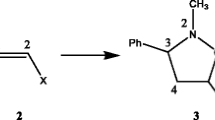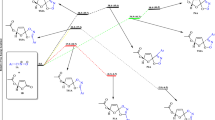Abstract
Out of several pericyclic reactions, Diels-Alder (DA) reaction is one of the most widely used synthetic processes. In the present work, several models and methodologies have been used to determine and to analyze the plausible mechanism of some representative DA cycloaddition reactions. A comparison between the dual descriptor and the bond reactivity indices corresponding to the natural bond orbital of the reagents is included, which provides a complete description of the plausible reaction mechanism. In the next step, two very recent models are used to determine the local electronic density transfer and redistribution between the reactants involved. The description of the local electronic density transfer has been made in two stages; first, the variation in the net charge on the atoms is obtained, and then, the electronic density transfer between the natural bond orbitals is calculated. The values obtained using the two models are correlated with the experimental rate constants of the reactions. Finally, the natural bond orbitals are obtained at several steps along the reaction path and the variation in their partial occupation is compared with the corresponding electron density transfer among these orbitals. Furthermore, frontier molecular orbital (FMO) approach has been employed to understand the more feasible way of interaction between the DA pair. Relative electrophilicity descriptors like net electrophilicity (∆ω±), net reactivity index (NRI, Δ\( {\omega}_R^{\pm } \)), and electrophilicity difference (∆ω) between DA pairs have also been employed to describe the studied reaction mechanisms especially whether they follow non-polar-concerted/polar-stepwise pathway along with their classification in terms of normal or inverse electron demand. Furthermore, adaptive natural density partitioning method (AdNDP) and energy decomposition analyses (EDA) in conjunction with natural orbital for chemical valence (NOCV) have been made use of in order to analyze the actual bonding situation in the transition state (TS).











Similar content being viewed by others
References
Loncharich RJ, Brown FK, Houk K (1989) Transition structures of the Diels-Alder reaction of butadiene with acrolein. J Org Chem 54:1129–1134
Houk KN, Gonzalez J, Li Y (1995) Pericyclic reaction transition states: passions and punctilios, 1935-1995. Acc Chem Res 28:81–90
Woodward RB, Hoffmann R (1969) The conservation of orbital symmetry. Angew Chem Int Ed 8:781–853
Fukui K (1982) The role of frontier orbitals in chemical reactions (Nobel Lecture). Angew Chem Int Ed 21:801–809
Hartree D (1928) The wave mechanics of an atom with a non-coulomb central field. Part iii. Term values and intensities in series in optical spectra. In: Mathematical Proceedings of the Cambridge Philosophical Society: Cambridge University Press. 24: 426-437
Hartree D (1929) The distribution of charge and current in an atom consisting of many electrons obeying Dirac’s equations, in: Mathematical Proceedings of the Cambridge Philosophical Society: Cambridge University Press, 25: 225–236
Fock V (1930) Näherungsmethode zur Lösung des quantenmechanischen Mehrkörperproblems. Z Phys 61:126–148
Parr RG and Yang W (1989) Density-functional theory of atoms and molecules: Oxford University Press, Oxford, New York
Chermette H (1999) Chemical reactivity indexes in density functional theory. J Comput Chem 20:129–154
Kohn W, Becke AD, Parr RG (1996) Density functional theory of electronic structure. J Phys Chem 100:12974–12980
March NH (1982) Electron density theory of atoms and molecules. J Phys Chem 86:2262–2267
Hohenberg P, Kohn W (1964) Inhomogeneous electron gas. Phys Rev 136:B864
Chattaraj PK, Fuentealba P, Gómez B, Contreras R (2000) Woodward−hoffmann rule in the light of the principles of maximum hardness and minimum polarizability: DFT and Ab initio SCF studies. J Am Chem Soc 122:348–351
Sablon N, de Proft F, Geerlings P (2009) Reformulating the Woodward-Hoffmann rules in a conceptual density functional theory context: the case of sigmatropic reactions. Croatica Chem Acta 82:157–164
De Proft F, Ayers PW, Fias S, Geerlings P (2006) Woodward-Hoffmann rules in density functional theory: initial hardness response. J Chem Phys 125:214101
De Proft F, Chattaraj P, Ayers P, Torrent-Sucarrat M, Elango M, Subramanian V, Giri S, Geerlings P (2008) Initial hardness response and hardness profiles in the study of Woodward–Hoffmann rules for electrocyclizations. J Chem Theo Comput 4:595–602
Geerlings P, De Proft F (2008) Conceptual DFT: the chemical relevance of higher response functions. Phys Chem Chem Phys 10:3028–3042
Morell C, Labet V, Grand A, Ayers PW, De Proft F, Geerlings P, Chermette H (2009) Characterization of the chemical behavior of the low excited states through a local chemical potential. J Chem Theor Comput 5:2274–2283
Jaque P, Correa JV, De Proft F, Toro-Labbe A, Geerlings P (2010) Regaining the Woodward–Hoffmann rules for chelotropic reactions via conceptual DFT. Canadian J Chem 88:858–865
Geerlings P, Ayers PW, Toro-Labbé A, Chattaraj PK, De Proft F (2012) The Woodward–Hoffmann rules reinterpreted by conceptual density functional theory. Acc Chem Res 45:683–695
Correa JV, Jaque P, Geerlings P, Toro-Labbé A (2012) Electronic activity in chelotropic and cycloaddition reactions. Int J Quantum Chem 112:2142–2153
Sauer J, Lang D, Wiest H (1964) Eine Studie der Diels-Alder-Reaktion, II. Das Additionsvermögen cis-trans-isomerer Dienophile bei Dienadditionen (mit und ohne Aluminiumchlorid-Katalyse). Chem Ber 97:3208–3218
Wassermann A (1965) Diels-Alder reactions: organic background and physicochemical aspects. Elsevier
Padwa A (1984) 1, 3-dipolar cycloaddition chemistry, vol 1. Wiley-interscience
Ollis WD (1979) Comprehensive organic chemistry: the synthesis and reactions of organic compounds. Pergamon Press
Diels O, Alder K (1928) Syntheses in the hydroaromatic series. I. Addition of “diene” hydrocarbons. Justus Liebigs Ann Chem 460:98–122
Ess DH, Jones GO, Houk K (2006) Conceptual, qualitative, and quantitative theories of 1, 3-dipolar and Diels–Alder cycloadditions used in synthesis. Adv Syn Cat 348:2337–2361
Morales-Bayuelo A, Sánchez-Márquez J, Jana G, Chattaraj PK (2018) Analyzing torquoselectivity in a series of unusual ring-opening reactions through bond reactivity indices and the adaptive natural density partitioning method. Int J Quantum Chem 118:e25778
Fujimoto H, Fukui K (1972) Molecular orbital theory of chemical reactions. In: Adv. Quantum Chem., vol 6. Elsevier, pp 177–201
Eyring H (1935) The activated complex and the absolute rate of chemical reactions. Chem Rev 17:65–77
Laidler KJ, King MC (1983) Development of transition-state theory. J Phys Chem 87:2657–2664
Walsh R, Wells JM (1976) The kinetics of reversible Diels–Alder reactions in the gas phase. Part II. Cyclopentadiene and ethylene. J Chem Soc Perkin Trans 2:52–55
Pearson RG (1997) Chemical hardness. Wiley-VCH, Weinheim
Chattaraj PK, Parr RG (1993) Density functional theory of chemical hardness. In: Chemical Hardness. Springer, pp 11–25
Parr RG, Szentpaly L, Liu S (1999) Electrophilicity index. J Am Chem Soc 121:1922–1924
Chattaraj PK, Sarkar U, Roy DR (2006) Electrophilicity index. Chem Rev 106:2065–2091
Chattaraj PK, Roy D (2007) Perennial review: update 1 of Chem. Rev. 106, 2065 (2006). Chem Rev 107
Chattaraj PK, Giri S, Duley S (2011) Perennial review: update 2 of Chem. Rev.(2006), 106, 2065. Chem Rev 111
Calais JL (1993) Density-functional theory of atoms and molecules. RG Parr and W. Yang, Oxford University Press, New York, Oxford, 1989. IX+ 333 pp. Price£ 45.00. Int J Quantum Chem 47:101–101
Liu S-B (2009) Conceptual density functional theory and some recent developments. Acta Phys -Chim Sin 25:590–600
Geerlings P (1793) Proft FDe, Langenaeker W. Chem Rev 103:2003
Pearson R, Chattaraj PK (2008) The hard-soft acid-base principle. Chemtracts: Inorg Chem 21:1–7
Pearson RG (1963) Hard and soft acids and bases. J Am Chem Soc 85:3533–3539
Chattaraj PK (2009) Chemical reactivity theory: a density functional view. CRC press
Kohn W, Sham LJ (1965) Self-consistent equations including exchange and correlation effects. Phys Rev 140:A1133
Koopmans T (1933) Ordering of wave functions and eigenenergies to the individual electrons of an atom. Physica 1:104–113
Huang M, Maynard A, Turpin JA, Graham L, Janini GM, Covell DG, Rice WG (1998) Anti-HIV agents that selectively target retroviral nucleocapsid protein zinc fingers without affecting cellular zinc finger proteins. J Med Chem 41:1371–1381
Gazquez JL, Cedillo A, Vela A (2007) Electrodonating and electroaccepting powers. J Phys Chem A 111:1966–1970
Chakraborty A, Das R, Giri S, Chattaraj PK (2011) Net reactivity index (Δω). J Phys Org Chem 24:854–864
Chattaraj PK, Chakraborty A, Giri S (2009) Net electrophilicity. J Phys Chem A 113:10068–10074
Sánchez-Márquez J, García V, Zorrilla D, Fernández M (2019) New insights in conceptual DFT: new model for the calculation of local reactivity indices based on the Sanderson's principle. Int J Quantum Chem 119:e25844
Becke AD (1992) Density-functional thermochemistry. I. The effect of the exchange-only gradient correction. J Chem Phys 96:2155–2160
Frisch MJ, Pople JA, Binkley JS (1984) Self-consistent molecular orbital methods 25. Supplementary functions for Gaussian basis sets. J Chem Phys 80:3265–3269
Lee C, Yang W, Parr RG (1988) Development of the Colle-Salvetti correlation-energy formula into a functional of the electron density. Phys Rev B 37:785
Gaussian 09, Revision A.02, Frisch MJ, Trucks GW, Schlegel HB, Scuseria GE, Robb MA, Cheeseman JR, Scalmani G, Barone V, Petersson GA, Nakatsuji H, Li X, Caricato M, Marenich AV, Bloino J, Janesko BG, Gomperts R, Mennucci B, Hratchian HP, Ortiz JV, Izmaylov AF, Sonnenberg JL, Williams-Young D, Ding F, Lipparini F, Egidi F, Goings J, Peng B, Petrone A, Henderson T, Ranasinghe D, Zakrzewski VG, Gao J, Rega N, Zheng G, Liang W, Hada M, Ehara M, Toyota K, Fukuda R, Hasegawa J, Ishida M, Nakajima T, Honda Y, Kitao O, Nakai H, Vreven T, Throssell K, Montgomery JA Jr, Peralta JE, Ogliaro F, Bearpark MJ, Heyd JJ, Brothers EN, Kudin KN, Staroverov VN, Keith TA, Kobayashi R. Normand J, Raghavachari K, Rendell AP, Burant JC, Iyengar SS, Tomasi J, Cossi M, Millam JM, Klene M, Adamo C, Cammi R, Ochterski JW, Martin RL, Morokuma K, Farkas O, Foresman JB, Fox DJ. Gaussian, Inc., Wallingford CT, 2009
Sánchez-Márquez J, Zorrilla D, Sánchez-Coronilla A, Desireé M, Navas J, Fernández-Lorenzo C, Alcántara R, Martín-Calleja J (2014) Introducing “UCA-FUKUI” software: reactivity-index calculations. J Mol Model 20:2492
Zubarev DY, Boldyrev AI (2008) Developing paradigms of chemical bonding: adaptive natural density partitioning. Phys Chem Chem Phys 10:5207–5217
Lu T, Chen F (2012) Multiwfn: a multifunctional wavefunction analyzer. J Comput Chem 33:580–592
Gao W, Feng H, Xuan X, Chen L (2012) A theoretical study of N–H··· π H-bond interaction of pyrrole: from clusters to the liquid. Mol Phys 110:2151–2161
Te Velde G, Bickelhaupt FM, Baerends EJ, Fonseca Guerra C, van Gisbergen SJ, Snijders JG, Ziegler T (2001) Chemistry with ADF. J Comput Chem 22:931–967
Parr RG, Donnelly RA, Levy M, Palke WE (1978) Electronegativity: the density functional viewpoint. J Chem Phys 68:3801–3807
Sanderson R (1951) An interpretation of bond lengths and a classification of bonds. Science 114:670–672
Sanderson RT (1976) Chemical bonds in organic compounds. Sun and Sand Publishing Company
Sanderson R (2012) Polar covalence. Elsevier
Sánchez-Márquez J (2019) New advances in conceptual-DFT: an alternative way to calculate the Fukui function and dual descriptor. J Mol Model 25:123
Parr RG, Pearson RG (1983) Absolute hardness: companion parameter to absolute electronegativity. J Am Chem Soc 105:7512–7516
Sánchez-Márquez J (2016) Introducing new reactivity descriptors:“bond reactivity indices.” Comparison of the new definitions and atomic reactivity indices. J Chem Phys 145:194105
Foster RA, Willis MC (2013) Tandem inverse-electron-demand hetero-/retro-Diels–Alder reactions for aromatic nitrogen heterocycle synthesis. Chem Soc Rev 42:63–76
Sauer J, Sustmann R (1980) Mechanistic aspects of Diels-Alder reactions: a critical survey. Angew Chem Int 19(10):779–807
Github source. https://zenodo.org/record/2648092#.XLwJdpnQhPY). Access Date: 17 Apr 2019
Tkachenko NV, Boldyrev AI (2019) Chemical bonding analysis of excited states using the adaptive natural density partitioning method. Phys Chem Chem Phys 21:9590–9596
Acknowledgments
PKC thanks the DST, New Delhi, for the J. C. Bose National Fellowship. AM thanks the GIBACUS (Universidad del Sinú, sectional Cartagena), and JS thanks the Departamento de Química-Física for the support of this investigation. GJ thanks IIT, Kharagpur for his fellowship.
Author information
Authors and Affiliations
Corresponding authors
Ethics declarations
Conflict of interest
The authors declare that they have no conflict of interest.
Additional information
Publisher’s note
Springer Nature remains neutral with regard to jurisdictional claims in published maps and institutional affiliations.
Electronic supplementary material
ESM 1
(DOC 2974 kb)
Rights and permissions
About this article
Cite this article
Morales-Bayuelo, A., Sánchez-Márquez, J., Jana, G. et al. A conceptual DFT analysis of the plausible mechanism of some pericyclic reactions. Struct Chem 31, 1745–1756 (2020). https://doi.org/10.1007/s11224-020-01527-7
Received:
Accepted:
Published:
Issue Date:
DOI: https://doi.org/10.1007/s11224-020-01527-7




